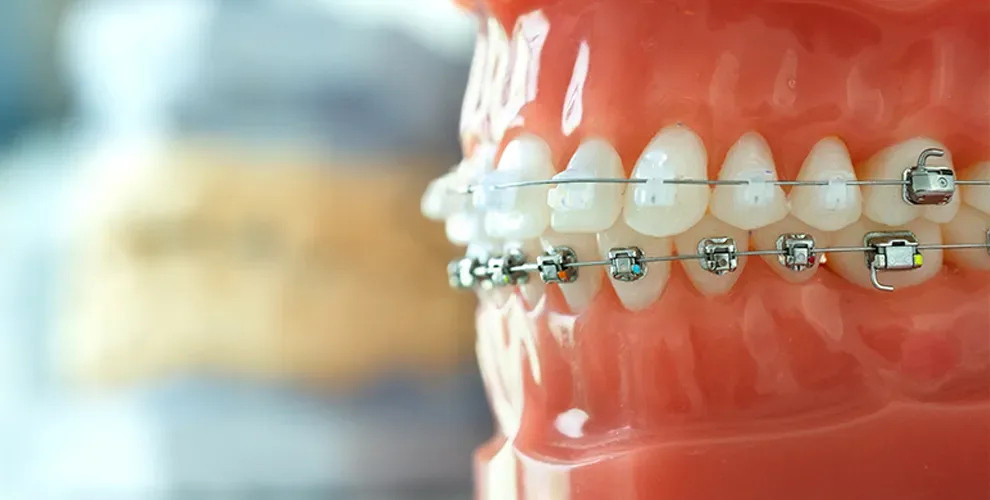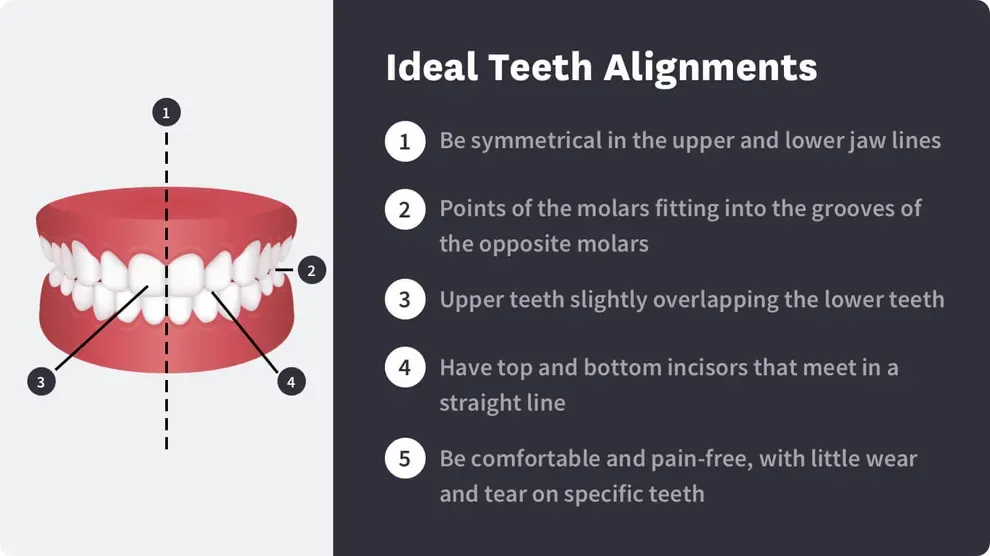What Does Ideal Teeth Alignment Look Like?

Table of Contents
- Ideal Teeth Alignment
- Incorrect Teeth Alignment Dangers
- Proper Alignment Influencing Factors
- Malocclusions
- Grading of Malocclusions
- Options for Fixing Tooth Alignment
- Getting Proper Dental Care
- Ideal Teeth Alignment FAQs
- References
While each person’s bite is a little bit different, dentists base healthy mouths on ideal teeth alignment or a normal bite occlusion.
Almost no one has a perfect bite from the time their adult teeth come in. Even people who seem to have perfectly straight teeth when they smile may have some misalignment that impacts their oral health.
If your teeth are crooked, don't worry. There are plenty of treatment options.

What Does Ideal teeth Alignment Look Like?
Ideal teeth alignment should involve the following:
Upper teeth slightly overlapping the lower teeth
Points of the molars fitting into the grooves of the opposite molars
Symmetry between the upper and lower jaw lines
Top and bottom incisors that meet in a straight line
Be comfortable and pain-free, with little wear and tear on specific teeth
What are the Dangers of Incorrect Teeth Alignment?
If your teeth do not meet properly, you may struggle with some of these issues:
It's hard to keep your teeth clean when they're crossed or filled with gaps. And when you eat, your food can get caught in your teeth. Trapped food plus poor cleaning can lead to plaque and decay.
Teeth that touch and bang against each other can get damaged. Each time you bite down, you could do even more damage. Worn enamel and cracked teeth can result.
Trapped food and bacteria buildup can lead to odors. Your family may notice problems when you speak, sing, or eat.
Factors that Influence Proper Alignment
Why are your teeth in unusual positions? Some factors are outside your control. Knowing what these issues are can help you decide what to do next.
Proper alignment can be influenced by the following:
Skeletal structure
Tooth size
Shape of your teeth
Position of your teeth
Genetics determine the size and shape of your teeth and jaw, which can also impact how serious any misalignment or malocclusions are.
Many people have teeth that are crowded or spaced. They may have a jaw that is too small for the upper palate or vice versa, or they might have an overbite or underbite.
Malocclusions of the Teeth or Jaw
The term malocclusion is Latin for “bad bite.” The American Association of Orthodontics says the term applies when teeth meet improperly or not at all.
A malocclusion could involve the following:
Spacing, or gaps between your teeth
Crowding, where teeth overlap and thrust each other out of line
Overbites, when the top teeth are too far in front of the lower teeth
Underbites, when the bottom teeth protrude in front of the top teeth
Crossbites, when the upper teeth sit inside the lower teeth. This can occur with the front or back teeth
Open bites, when the front teeth do not overlap the bottom teeth.
Grading of Malocclusions
There are three diagnosable grades of malocclusions.
Class 1: The upper teeth slightly overlap the lower teeth, but it is considered normal.
Class 2: The upper jaw and teeth significantly overlap the lower jaw and teeth.
Class 3: The lower jaw and teeth jut in front of the upper jaw and teeth.
How do you know if you have ideal teeth alignment or a normal bite occlusion? The best way to know is to talk to your dentist during a regular checkup, or get assessed by an aligner company.
Options for Fixing Tooth Alignment Issues
About a quarter of all adults don't like smiling because of their teeth. If a crowded, painful set of teeth keeps you from expressing your emotions, you can get help.
Three main options exist:
Your dentist affixes brackets to your teeth and then slides wires between them. The wires get shorter with each dental visit, and slowly, your teeth are pulled into their proper positions.
Braces can be costly, and the brackets can scrape and cut your tongue and lips. But this method is appropriate for people with teeth far out of alignment. It's a time-tested method for effectively straightening your teeth.
One of the most popular ways to straighten teeth is using clear aligners. Your dentist can help you fit these aligners if you have severe misalignment issues. If you have mild to moderate bite problems, mail-order aligners may be a good option.
These aligners are made by dental professionals based on impressions you send in, so they will help you get your smile perfect. They are often less expensive than clear aligners from your dentist, and they take less time than traditional braces.
Are your teeth out of alignment because your jaw is too short or narrow? Your dentist can apply devices on the arch of your mouth, slowly nudging your jaw into a new shape and size. A device like this can give your teeth more breathing room, which could help ease alignment problems.
Expanders are sometimes used in conjunction with aligners and braces. Your teeth may not take up new positions without encouragement.
Getting Proper Dental Care Can Help You Get Ideal Teeth Alignment
Your teeth will move throughout your life. In fact, some of your teeth will start to move when you enter your 20s, and they'll keep moving based on how you use them. If you grit your teeth, chew hard foods, or opt out of dental care, they'll move even more.
You can slow or stop this process by doing the following:
Chewing the right way: Your teeth aren't tools. Pick up scissors and other devices instead of using your teeth.
Keeping them clean: Brush and floss regularly. Ask your doctor if dental rinses are right for you too.
Visiting a dentist regularly: See a dental professional for checkups and cleanings. Never skip your appointments.
Ideal Teeth Alignment Frequently Asked Questions
A well-aligned mouth doesn't cause pain at rest or while working. Your teeth aren't chipped or ground down due to uneven forces, and your tongue and cheeks are free from scratches and bite marks.
During your dentist's checkup visits, words like malocclusion, crossbite, and open bite don't come up.
A healthy jaw can bite down in two ways:
Front teeth tap: You're taking a bite of something like a cracker. Your front and lower middle teeth touch to snap off a bite. But your lower teeth don't touch during this movement.
Back teeth tap: You're chewing the bite of cracker. Your front teeth no longer touch as the upper incisors slide over their lower cousins. But your back teeth touch.
Can't visualize this movement? Grab some crackers and experiment. If all of your teeth touch all of the time when you're biting, you're likely dealing with misalignment.
While you're resting, your teeth should be apart. You could be dealing with a tooth alignment or a jaw issue if they're touching or clenched.
Your jaw muscles push your mouth open and closed. If you're keeping those fibers active, you're grinding those teeth together when they should be resting.
